The output that I get is just the reference image and no bounding box is seen in the output. I have tried this code from this website: https://www.sicara.fr/blog-technique/object-detection-template-matching
Here's the reference image Reference Image
Here are the templates: 1:

templates 2:

templates 3:

As compared to the website, using the code the output should look like this:
Expected Output:

I am expecting to have this output as discussed in the website, however, when I tried to run this code, nothing seems to be detected. Here is the code that I copied:
import cv2
import numpy as np
DEFAULT_TEMPLATE_MATCHING_THRESHOLD = 0.9
class Template:
"""
A class defining a template
"""
def __init__(self, image_path, label, color, matching_threshold=DEFAULT_TEMPLATE_MATCHING_THRESHOLD):
"""
Args:
image_path (str): path of the template image path
label (str): the label corresponding to the template
color (List[int]): the color associated with the label (to plot detections)
matching_threshold (float): the minimum similarity score to consider an object is detected by template
matching
"""
self.image_path = image_path
self.label = label
self.color = color
self.template = cv2.imread(image_path)
self.template_height, self.template_width = self.template.shape[:2]
self.matching_threshold = matching_threshold
image = cv2.imread("reference.jpg")
templates = [
Template(image_path="Component1.jpg", label="1", color=(0, 0, 255), matching_threshold=0.99),
Template(image_path="Component2.jpg", label="2", color=(0, 255, 0,) , matching_threshold=0.91),
Template(image_path="Component3.jpg", label="3", color=(0, 191, 255), matching_threshold=0.99),
detections = []
for template in templates:
template_matching = cv2.matchTemplate(template.template, image, cv2.TM_CCORR_NORMED)
match_locations = np.where(template_matching >= template.matching_threshold)
for (x, y) in zip(match_locations[1], match_locations[0]):
match = {
"TOP_LEFT_X": x,
"TOP_LEFT_Y": y,
"BOTTOM_RIGHT_X": x + template.template_width,
"BOTTOM_RIGHT_Y": y + template.template_height,
"MATCH_VALUE": template_matching[y, x],
"LABEL": template.label,
"COLOR": template.color
}
detections.append(match)
def compute_iou(boxA, boxB):
xA = max(boxA["TOP_LEFT_X"], boxB["TOP_LEFT_X"])
yA = max(boxA["TOP_LEFT_Y"], boxB["TOP_LEFT_Y"])
xB = min(boxA["BOTTOM_RIGHT_X"], boxB["BOTTOM_RIGHT_X"])
yB = min(boxA["BOTTOM_RIGHT_Y"], boxB["BOTTOM_RIGHT_Y"])
interArea = max(0, xB - xA + 1) * max(0, yB - yA + 1)
boxAArea = (boxA["BOTTOM_RIGHT_X"] - boxA["TOP_LEFT_X"] + 1) * (boxA["BOTTOM_RIGHT_Y"] - boxA["TOP_LEFT_Y"] + 1)
boxBArea = (boxB["BOTTOM_RIGHT_X"] - boxB["TOP_LEFT_X"] + 1) * (boxB["BOTTOM_RIGHT_Y"] - boxB["TOP_LEFT_Y"] + 1)
iou = interArea / float(boxAArea + boxBArea - interArea)
return iou
def non_max_suppression(objects, non_max_suppression_threshold=0.5, score_key="MATCH_VALUE"):
"""
Filter objects overlapping with IoU over threshold by keeping only the one with maximum score.
Args:
objects (List[dict]): a list of objects dictionaries, with:
{score_key} (float): the object score
{top_left_x} (float): the top-left x-axis coordinate of the object bounding box
{top_left_y} (float): the top-left y-axis coordinate of the object bounding box
{bottom_right_x} (float): the bottom-right x-axis coordinate of the object bounding box
{bottom_right_y} (float): the bottom-right y-axis coordinate of the object bounding box
non_max_suppression_threshold (float): the minimum IoU value used to filter overlapping boxes when
conducting non-max suppression.
score_key (str): score key in objects dicts
Returns:
List[dict]: the filtered list of dictionaries.
"""
sorted_objects = sorted(objects, key=lambda obj: obj[score_key], reverse=True)
filtered_objects = []
for object_ in sorted_objects:
overlap_found = False
for filtered_object in filtered_objects:
iou = compute_iou(object_, filtered_object)
if iou > non_max_suppression_threshold:
overlap_found = True
break
if not overlap_found:
filtered_objects.append(object_)
return filtered_objects
NMS_THRESHOLD = 0.2
detections = non_max_suppression(detections, non_max_suppression_threshold=NMS_THRESHOLD)
image_with_detections = image.copy()
for detection in detections:
cv2.rectangle(
image_with_detections,
(detection["TOP_LEFT_X"], detection["TOP_LEFT_Y"]),
(detection["BOTTOM_RIGHT_X"], detection["BOTTOM_RIGHT_Y"]),
detection["COLOR"],
2,
)
cv2.putText(
image_with_detections,
f"{detection['LABEL']} - {detection['MATCH_VALUE']}",
(detection["TOP_LEFT_X"] + 2, detection["TOP_LEFT_Y"] + 20),
cv2.FONT_HERSHEY_SIMPLEX, 0.5,
detection["COLOR"], 1,
cv2.LINE_AA,
)
# NMS_THRESHOLD = 0.2
# detection = non_max_suppression(detections, non_max_suppression_threshold=NMS_THRESHOLD)
print("Image written to file-system: ", status)
cv2.imshow("res", image_with_detections)
cv2.waitKey(0)
this is how his final output looks like: 5
Here's my attempt in detecting the larger components, the code was able to detect them and here is the result: Result
Here are the resize templates and the original components that I wanted to detect but unfortunately can't:




